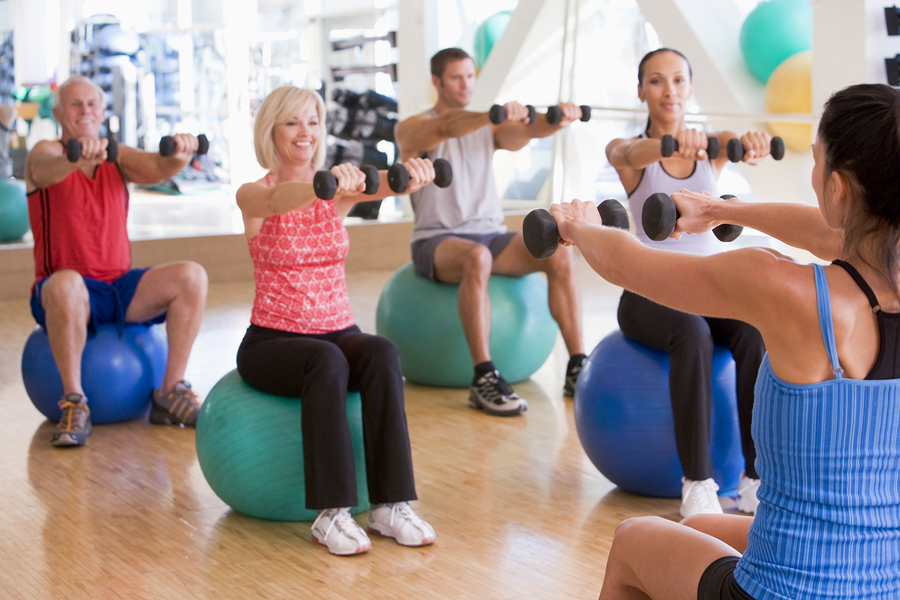Tips on exercising with arthritis
Exercise has been shown to improve arthritic symptoms as well as benefiting our bodies in so many other ways so it is extremely important to be active.
Dan Webster and Dan Poulter from AXA PPP healthcare explore which type of exercise may be most beneficial for arthritic joints and why.
The word arthritis is used to describe pain, swelling and stiffness in a joint and there are estimated to be approximately 10 million people affected in the UK. There are over 200 different types of arthritis, two of the most common are osteoarthritis and rheumatoid arthritis.
Osteoarthritis
Typically occurring in those over 40 years of age, osteoarthritis is a degenerative joint disease affecting approximately 9 million people in the UK.
Osteoarthritis occurs when the protective cartilage that cushions the ends of your bones wears down over time causing changes to the bone, tendons and ligaments causing inflammation. Although osteoarthritis can damage any joint, the disorder most commonly affects joints in your hands, knees, hips and spine. Causes can be as a result of an injury or overuse, although obesity, gender, race and family history may also be possible risk factors.
Rheumatoid arthritis
Rheumatoid arthritis is an auto-immune disease and is less common than osteoarthritis, affecting approximately 400,000 people in the UK but again predominately in those over 40 years of age.
The immune system which usually fights infection attacks the cells that line the joints, causing pain and inflammation and can affect more than just the joints.
Exercising with arthritis
Being active is the main way to relieve symptoms of arthritis. So even if you feel that it is the last thing you want to do when in pain, it has been shown that exercise is key to improving your symptoms and even slowing down your condition.
Being inactive may lead to weakened muscles which will not be able to support the joints and so in turn may lead to increased tightness and ultimately more pain.
Contrast that with being active and it’s a ‘no brainer’. Exercise will not only help strengthen the muscles that support the joints but will also increase their flexibility and stability. Exercising should also assist with keeping to a healthy body weight which will further help by reducing extra strain on damaged joints. An added benefit is improved sleep which in turn should aid the body to repair itself.
Day to day function may also be improved with the correct type of exercise and intensity as it can help to prevent the breakdown of cartilage and so reduce inflammation and pain.
What type of exercise is most beneficial?
Ideally, an exercise programme should include a combination of different types of activity so the body will be benefit in different ways. It is most important, however, to choose a sport, exercise or activity that you enjoy as you will be more likely to stick at it.
Any activities should include some form of aerobic activity for at least 150 minutes over the course of the week; this is where your heart rate and breathing are raised. There should also be some type of resistance exercise per week to help build muscle and bone strength and finally, it is important to include some flexibility training for joint mobility and improved range of movement.
Aerobic activity
Choose low impact exercises that will not put unnecessary strain on joints. Aerobic exercise, from 3 to 5 days a week, will increase overall fitness and reduce the risk of cardiovascular disease. It should also help with maintaining a healthy body weight and give you more energy. Choose from exercises such as brisk walking, swimming, water aerobics and dancing.
Resistance exercise
Some muscle strengthening work, 2 to 3 days per week, will help to support and protect your joints. Large group muscle exercises using your own body weight, resistance bands, machines or free weights (such as dumbbells) are recommended.
Flexibility training
Simple stretching exercises will help improve range of motion along with helping to minimise injury before and after exercise.
Move slowly into a stretch position to the point where you feel a stretch surrounding the joint, but not pain. Hold the stretch for 5-10 seconds and repeat several times. Once flexibility improves, stretches can be held for longer.
Tips on how to start exercising with arthritis
Take things slowly at first –if you’re new to exercise or if you experience sporadic pain and/or discomfort due to your arthritis then don’t rush. Gradually build the intensity and/or duration of activity so you get used to the activity you’re doing.
Stop if you feel pain – if you feel sudden pain when exercising then stop and seek professional guidance from a qualified sports professional or your GP. It may be that you just need to lower the intensity and work out what’s right for your body.
Don’t forget to warm up and cool down – this will prepare your body for exercise and will help to minimise injury. Find some complete warm-up and cool down videos from The Arthritis Foundation here
Go with a friend – if you’re new to exercising or struggling to stick to your plan then try exercising with a friend or join a class. It should then be easier to find the motivation you need.
Make time to include exercise in your life. Upping your activity levels and following these tips should not only help to improve your symptoms but also your overall wellbeing.
Disclaimer
All content on Silversurfers.com is provided for general information only, and should not be treated at all as a substitute for the medical advice of your own doctor or any other health care professional. Silversurfers will not be responsible or liable for any diagnosis made by a user based on the content on www.silversurfers.com and we are also not liable for the content of any external websites or links from or to Silversurfers to any other websites. Please always consult your own doctor if you’re in any way concerned about any aspect of your health.
Melina - Assistant Editor
Latest posts by Melina - Assistant Editor (see all)
- Banana bread with SunGold kiwis - February 20, 2025
- A tribute to Bob Marley - February 4, 2025
- Going to Work on an Egg! - January 29, 2025
- The Very Best of Petula Clark - January 14, 2025
- 50 Years of Coat Trends - January 12, 2025




















